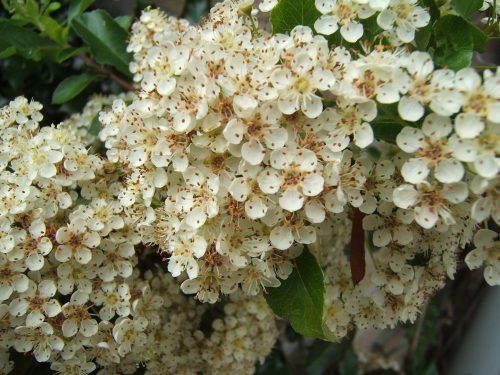Firethorns are evergreen shrubs of the ro
You are viewing the mobile-adapted version of the page.
The one for tablets, laptop and desktop also provides general information, such as origin, toxicity and cultivation.
Firethorn – (Pyracantha) a evergreen shrub of the rose family (Rosaceae). Firethorns are native to the area from southeastern Europe to southeastern Asia. Firethorn is related to Cotoneaster; firethorns have large sharp spines and Cotoneaster does not.
Firethorns can grow 4-6 meters tall. Flowering time is from late spring to early summer. Berries are produced in late summer and ripen in late fall. Firethorns offer nesting birds protection through the thorns. Blackbirds like to feast on the berries.
Firethorns hardly need pruning unless pruning is necessary to achieve a nicer balance in the shrub. Firethorns bloom on branches that are at least two years old.
The firethorn is an easy shrub that does well in any permeable, somewhat humous garden soil, but does not like chalky soil.
A firethorn is planted as a solitary, as a hedge or against a wall. Placed against a wall, a trellis of slats is necessary to guide the firethorn. Firethorns tolerate transplanting poorly.
Firethorns used to be kept out of regions with fruit growing (apples and pears) because the firethorn is susceptible to fire blight (Erwinia amylovora) and could infect apple and pear trees. There are now less sensitive hybrids of firethorns on the market that are less sensitive.
Bugs
Slightly misshapen leaf: aphid. Sometimes also scale insects.
Fungi & diseases
Flower clusters wilt early, turn brown and die. Leaves of young twigs curl, turning black and later brown. The top of the twigs curl over and droop. Sometimes some slime can be seen on the old wood: fire blight (Erwinia amylovora).
Olive green, brown-gray or black spots appear on the leaves. Rough spots appear on the branches. Affected berries dry up and turn black: apple scab (Venturia inaequalis).
Other
Young leaves wilt: night frost.
Few to no flowers can be caused by vigorous pruning or a cold spring which means there are few insects to provide pollination.
In autumn, the berries fall off early: the firethorn suffers from drought.

